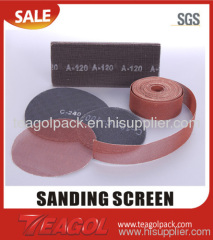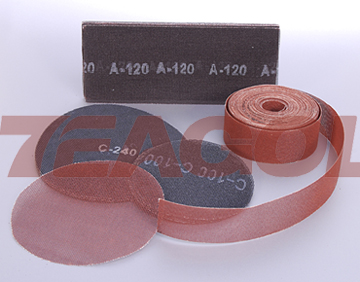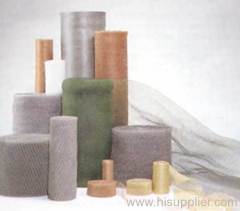
|
Anping Hongqi Metal Wire Mesh Products Co., Ltd.
|
Knitted Wire Meshes
| Payment Terms: | L/C,T/T |
| Place of Origin: | Hebei, China (Mainland) |
|
|
|
| Add to My Favorites | |
| HiSupplier Escrow |
Product Detail
Knitted wire mesh is a metal, ceramic or synthetic wire knitted into a mesh of interlocking loops. Special products according to client's requirement.
Knitted wire mesh is strong, flexible, and resilient—giving knitted wire mesh utility in a number of applications that other materials are unsuited for. The resiliency, or "springiness," coupled with heat and corrosion resistance makes knitted mesh ideal for applications where seals, sleeves and connections exist in extreme climate settings such as exhaust components and systems. The knitted mesh is ideal for sound attenuation, vibration and shock suppression, electromagnetic and radio frequency interference shielding (acting as a Faraday cage), filtration and scouring.
Density
Density refers to the mass of material per unit volume. It is related to the density of the original mesh and the amount of forming pressure used to compress the mesh into its final form. Determining the required mesh density to produce the specified final product density is a critical step in the design process. Proper density ensures optimal performance of the sealing, gasketing, filtration, heat transfer and separation applications.



Knitted wire mesh of interlocking loops. These loops can move relative to each other in the same plane without distorting the mesh, giving knitted mesh a two-way stretch. This cannot be done with woven meshes, as there is always some form of connection between the wires at the corners of the square openings. From a functional point of view, it is this flexibility that gives knitted mesh its unique advantages for industrial uses.
Forms of Knitted Mesh
Knitted mesh is produced on a cylindrical machine. The output of this machine is a continuous "stocking" of mesh, which is pulled through the knitter by take-up rollers. It can be used directly in this flattened form as an insulation covering or it can be further processed into several other basic forms.
Properties of Knitted Mesh
Knitted wire has distinct advantages over most competitive materials. Because each loop acts as a small spring when subjected to tensile or compressive stress, knitted metal has an inherent resiliency. If it's not distorted beyond its yield point, the material will resume its original shape when the stress is removed. Even when it's compressed into a special shape, a high degree of resiliency is retained. Varying the knitted structure, wire diameter, wire material and forming pressure used to create the part can control this characteristic.
Forms of Knitted Mesh
Knitted mesh is produced on a cylindrical machine. The output of this machine is a continuous "stocking" of mesh, which is pulled through the knitter by take-up rollers. It can be used directly in this flattened form as an insulation covering or it can be further processed into several other basic forms.
Flattened mesh is sometimes run through corrugating rolls to create crimped mesh. In this form, the corrugations act like springs for resiliency and give the mesh thickness.
Knitted wire mesh is also used to create compressed units for filtration, shock mounts and flame arrestors. In this case, the mesh is formed in a custom made die. These units are made in densities (% metal by volume) ranging from 10% to 70%. Compressed mesh is also made in a continuous strip form by running the mesh through calendaring rollers.
Mesh can be knitted directly into a hollow tube used by itself or knitted over wound-up mesh to make a cable or gasket core. It can also be rolled or padded to create filters, separators or flame arrestors. In all of the forms of mesh, density and wire dispersion are controlled closely to ensure optimum product performance and repeatability.
Properties of Knitted Mesh
Knitted wire has distinct advantages over most competitive materials. Because each loop acts as a small spring when subjected to tensile or compressive stress, knitted metal has an inherent resiliency. If it's not distorted beyond its yield point, the material will resume its original shape when the stress is removed. Even when it's compressed into a special shape, a high degree of resiliency is retained. Varying the knitted structure, wire diameter, wire material and forming pressure used to create the part can control this characteristic.
Knitted metal also provides high mechanical damping characteristics and non-linear spring rates. Vibration and mechanical shock can be effectively controlled to eliminate the violent resonant conditions and provide ample protection from dynamic overloads.
In compressed form, knitted metal can handle shock loadings up to the yield strength of the material itself. The load may be applied from any direction—up, down or in from all sides.
Our application engineers have the experience to determine the optimum density of compressed units within the range of 10% to 70%. This is important in applications such as liquid filtration and noise attenuation where flow resistance is critical.
When compressed, layered, calendared or wound knitted metal presents a "tortuous" path to liquids or gasses flowing through it. This increases filtration capability and particle retention capacity.
Among the most important property of knitted mesh units is the material itself. By careful selection of the material or combinations of materials, Metal Textiles can custom engineer solutions best suited for our customer's application—be it corrosive, ultra-high or cryogenic temperature, high pressure, radioactive, dirty, oily or other extreme conditions.
Most Commonly Knit Materials | |
|
|
Mesh Diameters
Mesh is normally knit from wires ranging in diameter from .0035" to .0200". In special applications, Metal Textiles has knit wires ranging in diameter from .0005" to .0350". These wires can be round or flat such as those used in Metal Textiles copper gauze for cleaning and in air-filtration applications where large surface areas of wire are needed. A round wire when flattened has approximately twice as much surface area.
Mesh is normally knit from wires ranging in diameter from .0035" to .0200". In special applications, Metal Textiles has knit wires ranging in diameter from .0005" to .0350". These wires can be round or flat such as those used in Metal Textiles copper gauze for cleaning and in air-filtration applications where large surface areas of wire are needed. A round wire when flattened has approximately twice as much surface area.
In filtration applications, wire diameter is perhaps the most important design variable. It directly affects flow, dirt holding capacity, pressure drop and cost. In general, larger diameter wire allows for higher flow but provides lower dirt holding capacity. Also, larger diameter wire is less expensive. Therefore, a balance must be struck between using a higher density filter of higher cost fine wire or a lesser density filter using lower cost heavy wire.
Density
Density refers to the mass of material per unit volume. It is related to the density of the original mesh and the amount of forming pressure used to compress the mesh into its final form. Determining the required mesh density to produce the specified final product density is a critical step in the design process. Proper density ensures optimal performance of the sealing, gasketing, filtration, heat transfer and separation applications.
Metal Textiles engineers are expert at determining proper density for specific requirements.
Applications of Knitted wire mesh |
| Knitted mesh is used in a variety of applications, including the following: |
|
The standard of Knitted wire mesh in china
The applied standard of Knitted wire mesh is the standard of Shanghai enterprise. The ex-number was Hu Q/SG12-1-79, and it has been replaced by new standard----Hu Q/YSZZ-88-91 since 1991. The standard prescribes the three types of gas-liquid filter screen, namely, standard type, high efficiency type and great penetration type. They are showed in the following pictures:
Standard type

High efficiency type

Great penetration type

our company has hundreds of types of Knitted wire mesh for the clients to choose, including the four types of SP\HP\DP and HR which are included in the HG/T21618-1998 standard of wire-mesh demister.
Other non-standard gas-liquid filter screens
we can also accept orders of non-standard meshwork against customer samples, such as multi-wire commingled weaving, different shape of gasket, bush etc.
Didn't find what you're looking for?
Post Buying Lead or contact
HiSupplier Customer Service Center
for help!
Related Search
Anping Wire Meshes
Knitted Wire Mesh
Knitted Wire Cloth
Knitted Wire Netting
Knitted Wire Mesh Filter
Wire Knitted Hose
More>>

.jpg)
.jpg)
.jpg)
.jpg)



.jpg)
.jpg)
.jpg)
.jpg)
.jpg)
.jpg)
.jpg)
.jpg)
.gif)
.jpg)
.jpg)
.jpg)
.jpg)
.jpg)
.gif)
.jpg)
.jpg)
.jpg)
.jpg)

